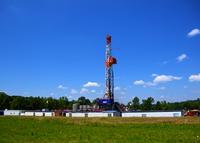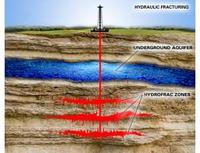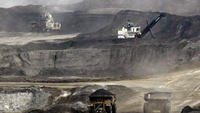-
New process doubles production, slashes costs of butanol
Butanol has a 30 percent higher energy content than ethanol, lower vapor pressure, and is less volatile, less flammable, and mixes well with gasoline; a new discovery should make butanol more attractive to the biofuel industry
-
-
Farmers upset by plan for water banking system

Depending on the depth of the drilling, it can take anywhere from two gallons to two million gallons of water to frack one well; drilling companies consumeenough water in their fracking operations to meet the needs of between 66,400 and 118,000 households; in the parched Midwest, farmers raise questions about water-use priorities
-
-
Wind farms pose risks to ultra-light aircraft
Airfields for ultra-light aircraft are typically constructed on level ground — and so are wind farms; do wind power plants generate turbulence that could endanger lightweight planes? A simulation can compute how these power plants influence aircraft at various wind speeds and wind directions
-
-
Study finds correlation between injection wells and small earthquakes

Most earthquakes in the Barnett Shale region of North Texas occur within a few miles of one or more injection wells used to dispose of wastes associated with petroleum production such as hydraulic fracturing fluids, according to new research
-
-
Improving oil recovery, aiding environmental cleanup
Researchers have taken a new look at an old, but seldom-used technique developed by the petroleum industry to recover oil, and learned more about why it works, how it could be improved, and how it might be able to make a comeback not only in oil recovery but also environmental cleanup
-
-
A second look at off-shore use of vertical-axis wind turbines

Wind energy researchers are re-evaluating vertical axis wind turbines (VAWTs) to help solve some of the problems of generating energy from offshore breezes; though VAWTs have been around since the earliest days of wind energy research, VAWT architecture could transform offshore wind technology
-
-
Conflict of interests charges surround two pro-fracking studies

Two recent studies — by research institutes at the University of Buffalo and the University of Texas — on the relationship between fracking and the contamination of groundwater, offered what was claimed to be scientific, peer-reviewed research which concluded that fracking does not contribute to such contamination; an examination of the two reports reveals that they were not properly reviewed according to accepted academic standards, and that their authors, and the research institutes which sponsored them, are heavily involved with companies which conduct fracking operations; the author of the University of Texas report sits on the board of a leading fracking company, where his compensation is more than twice as large as his UT salary; he did not disclose this fact in the study — or inform UT of this connection; UT is investigating
-
-
Replacing coal with natural gas would reduce global warming
A new study finds that a gas substitution scenario, in which natural gas replaces all coal power production and any new oil-powered facilities by midcentury, would realize 40 percent of the reduction in global warming that could be achieved with a full switch to low-carbon fuel sources; this is a less costly, and more feasible, option, than switching all electricity generation immediately and aggressively to non-fossil fuel sources such as solar, wind, and nuclear
-
-
Emissions from oil sands-derived fuels too varied for uniform low-carbon standards

Policy makers need to be cautious in setting new low-carbon standards for greenhouse gas emissions for oil sands-derived fuels as well as fuels from conventional crude oils; researchers found that lifecycle greenhouse gas (GHG) emissions vary widely across both actual surface mining and in situ oil sands operations and conventional crude cases reported in the scientific literature, depending on individual project operating conditions, technology used, and other factors
-
-
Small, local energy technologies to help sustain vital services during blackouts
Researchers suggest that rethinking the solution to sustaining electric power — namely, starting small — could keep critical services going, even when the high-voltage grid is crippled; the U.S. military is already taking steps to protect its power supplies in the event of a massive grid failure by adopting small, local energy technologies, and California governor Jerry Brown recently announced that he wants 12,000 megawatts of such power supplies in his state
-
-
Natural gas is good for the economy, environment
No matter how we drill it, using natural gas as an energy source is a smart move in the battle against global climate change and a good transition step on the road toward low-carbon energy from wind, solar, and nuclear power
-
-
A 10-year plan for Europe’s grid
A new study shows that 104 billion euro over ten years need to be invested in the refurbishment or construction of roughly 52,000 km of extra high voltage power lines and cables across Europe in order to add 3 percent generation capacity and the reliable integration of 125 GW of renewable energy sources
-
-
Forecast: sharp increase in world oil production capacity, risk of price collapse

Oil production capacity is surging in the United States and several other countries at such a fast pace that global oil output capacity is likely to grow by nearly 20 percent by 2020, which could prompt a plunge or even a collapse in oil prices; the growth in oil output owes largely to a combination of high oil prices and new technologies such as hydraulic fracturing that are opening up vast new areas and allowing extraction of “unconventional” oil such as tight oil, oil shale, tar sands and ultra-heavy oil
-
-
Predicting wave power helps double marine energy

The energy generated from the oceans could be doubled using new methods for predicting wave power; researchers have devised a means of accurately predicting the power of the next wave in order to make the technology far more efficient, extracting twice as much energy as is currently possible
-
-
Growing interest in prairie cordgrassas a biofuel source

Until recently, prairie cordgrass (Spartina pectinata) has received comparatively little attention because, unlike the other types of switchgrass, it is not a good forage crop; as interest in energy crops and in feedstock production for cellulosic biofuels increases, however, prairie cordgrass is receiving more attention because it grows well on marginal land
-
More headlines
The long view
Trump Is Fast-Tracking New Coal Mines — Even When They Don’t Make Economic Sense
In Appalachian Tennessee, mines shut down and couldn’t pay their debts. Now a new one is opening under the guise of an “energy emergency.”
Smaller Nuclear Reactors Spark Renewed Interest in a Once-Shunned Energy Source
In the past two years, half the states have taken action to promote nuclear power, from creating nuclear task forces to integrating nuclear into long-term energy plans.
